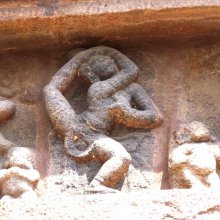Vidyudbhranta, Vidyudbhrānta, Vidyut-bhranta, Vidyudbhramta: 2 definitions
Introduction:
Vidyudbhranta means something in Hinduism, Sanskrit. If you want to know the exact meaning, history, etymology or English translation of this term then check out the descriptions on this page. Add your comment or reference to a book if you want to contribute to this summary article.
Images (photo gallery)
In Hinduism
Natyashastra (theatrics and dramaturgy)
Source: Wisdom Library: Nāṭya-śāstra1) Vidyudbhrānta (विद्युद्भ्रान्त).—One of the 108 karaṇas (minor dance movement) mentioned in the Nāṭyaśāstra chapter 4. The instructions for this vidyudbhrānta-karaṇa is as follows, “foot turned backwards and the two hands in the Maṇḍalāviddha gesture stretched very close to the head.”.
2) Vidyudbhrānta (विद्युद्भ्रान्त).—One of the 32 aṅgahāras (major dance movement) mentioned in the Nāṭyaśāstra chapter 4. The instructions for this vidyudbhrānta-aṅgahāra is as follows, “assuming Sūcī-karaṇa using the left foot first, and Vidyudbhrānta-karaṇa using the right foot first, then Sūcī-karaṇa with the right foot moved first, and Vidyudbhrānta with the left foot moved first, afterwards assuming Chinna-karaṇa, and turning round the Trika, then Latā and Kaṭicchinna Karaṇas.”.
A karaṇa represents a minor dance movements and combines sthāna (standing position), cārī (foot and leg movement) and nṛttahasta (hands in dancing position).
2) Vidyudbhrāntā (विद्युद्भ्रान्ता) refers to a one of the thirty-two cārīs, according to the Nāṭyaśāstra chapter 11. The Vidyudbhrāntā-cārī is classified as a ākāśikī, or “aerial”, of which there are sixteen in total. The term cārī refers to a “dance-step” and refers to the simultaneous movement of the feet (pāda), shanks (jaṅghā) and the hip (ūru). From these cārīs proceed dance as well as movements in general.
(Instructions of Vidyudbhrāntā): one foot turned to the back and after touching its top part to be stretched, and the head moved in a circle.
3) Vidyudbhrāntā (विद्युद्भ्रान्ता) is the name of a meter belonging to the Pratiṣṭhā or Supratiṣṭhā class of Dhruvā (songs) described in the Nāṭyaśāstra chapter 32:—“the metre which has in its feet of five syllables all long, is vidyudbhrāntā.”.

Natyashastra (नाट्यशास्त्र, nāṭyaśāstra) refers to both the ancient Indian tradition (shastra) of performing arts, (natya—theatrics, drama, dance, music), as well as the name of a Sanskrit work dealing with these subjects. It also teaches the rules for composing Dramatic plays (nataka), construction and performance of Theater, and Poetic works (kavya).
Languages of India and abroad
Kannada-English dictionary
Source: Alar: Kannada-English corpusVidyudbhrāṃta (ವಿದ್ಯುದ್ಭ್ರಾಂತ):—[noun] (dance.) one of the one hundred and eight coordinated movements of the hands and feet, in which one foot is turned backward and moved, the head is moved in a circle and the whole body is turned round like a wheel.
Kannada is a Dravidian language (as opposed to the Indo-European language family) mainly spoken in the southwestern region of India.
See also (Relevant definitions)
Relevant text
Search found 2 books and stories containing Vidyudbhranta, Vidyud-bhrānta, Vidyud-bhranta, Vidyudbhramta, Vidyudbhrāṃta, Vidyudbhrānta, Vidyudbhrāntā, Vidyut-bhranta, Vidyut-bhrānta, Vidyutbhranta; (plurals include: Vidyudbhrantas, bhrāntas, bhrantas, Vidyudbhramtas, Vidyudbhrāṃtas, Vidyudbhrāntas, Vidyudbhrāntās, Vidyutbhrantas). You can also click to the full overview containing English textual excerpts. Below are direct links for the most relevant articles:
Gati in Theory and Practice (by Dr. Sujatha Mohan)
Gati in aerial sphere < [Chapter 3 - Application of gati in Dṛśya-kāvyas]
Gati in classical dance form of Kathak < [Chapter 4 - Practice of Gati]
Performance of Cārī < [Chapter 2 - Concept and technique of Gati]
Natyashastra (English) (by Bharata-muni)
